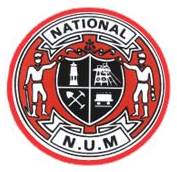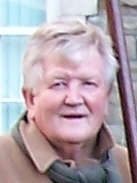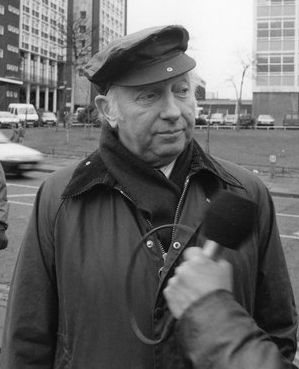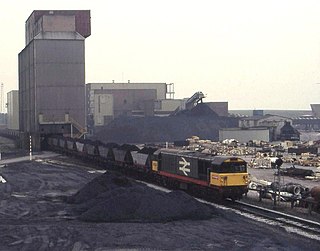Related Research Articles

The 1984–1985 United Kingdom miners' strike was a major industrial action within the British coal industry in an attempt to prevent closures of pits that the government deemed "uneconomic" in the coal industry, which had been nationalised in 1947. It was led by Arthur Scargill of the National Union of Mineworkers (NUM) against the National Coal Board (NCB), a government agency. Opposition to the strike was led by the Conservative government of Prime Minister Margaret Thatcher, who wanted to reduce the power of the trade unions.

The Battle of Orgreave was a violent confrontation on 18 June 1984 between pickets and officers of the South Yorkshire Police (SYP) and other police forces, including the Metropolitan Police, at a British Steel Corporation (BSC) coking plant at Orgreave, in Rotherham, South Yorkshire, England. It was a pivotal event in the 1984–1985 UK miners' strike, and one of the most violent clashes in British industrial history.

Ollerton is a town and former civil parish, now in the parish of Ollerton and Boughton, in the Newark and Sherwood district, in the county of Nottinghamshire, England, on the edge of Sherwood Forest in the area known as the Dukeries. The population of Ollerton and Boughton at the 2011 census was 9,840.

The National Union of Mineworkers (NUM) is a trade union for coal miners in Great Britain, formed in 1945 from the Miners' Federation of Great Britain (MFGB). The NUM took part in three national miners' strikes, in 1972, 1974 and 1984–85. Following the 1984–85 strike, and the subsequent closure of most of Britain's coal mines, it became a much smaller union. It had around 170,000 members when Arthur Scargill became leader in 1981, a figure which had fallen in 2023 to an active membership of 82.
Manton is a former pit village and suburb of south-east Worksop in north Nottinghamshire, England.

Woolley Colliery is a village in Wakefield district in West Yorkshire, England. The village is near the border with South Yorkshire. The former colliery was in the Wakefield Rural Ward in West Yorkshire. The village is known locally as Mucky Woolley, as a tribute to its coalmining heritage and to distinguish it from the more affluent village of Woolley two miles away.
The Union of Democratic Mineworkers (UDM) was a British trade union for coal miners based in Nottinghamshire, England, established in 1985, following the 1984–85 miners' strike, when the Nottinghamshire Area of the National Union of Mineworkers (NUM) was involved in a number of disputes with the National Executive Committee that led to a split from the NUM. In ballots on joining with Nottinghamshire in a new union, the South Derbyshire Area of the NUM voted in favour by 51% and the Colliery Workers and Allied Trades Association by almost 100%.

Michael McGahey was a Scottish miners' leader and communist. He had a distinctive gravelly voice, and described himself as "a product of my class and my movement".

The National Association of Colliery Overmen, Deputies and Shotfirers (NACODS) is an organisation representing former colliery deputies and under-officials in the coal industry.

The Lofthouse Colliery disaster was a mining accident in Lofthouse, in the West Riding of Yorkshire, England, on Wednesday 21 March 1973, in which seven mine workers died when workings flooded.
Philip Gordon Weekes was a Welsh mining engineer. As the National Coal Board's manager of the South Wales coalfields, Weekes played an important role mediating between the two sides of the miners' strike of 1984-85 in England, Scotland and Wales.

Tyrone O'Sullivan was a Welsh trade unionist who was Branch Secretary of the National Union of Mineworkers (NUM) and Chairman of Goitre Tower Anthracite Ltd., the owners of Tower Colliery.
The Kent Miners' Association was a trade union in the United Kingdom which existed between 1915 and 1945, representing coal miners in the county of Kent. After 1945 it was reorganised as the Kent Area of the National Union of Mineworkers.
Sir Sidney Ford, MBE was a British trade union leader.
The Battle of Saltley Gate was the mass picketing of a fuel storage depot in Birmingham, England, in February 1972 during a national miners' strike. When the strike began on 9 January 1972, it was generally considered that the miners "could not possibly win." Woodrow Wyatt, writing in the Daily Mirror, said: "Rarely have strikers advanced to the barricades with less enthusiasm or hope of success... The miners have more stacked against them than the Light Brigade in their famous charge." The picketing of the fuel depot – out of which tens of thousands of tons of coke fuel were being distributed nationwide – became a pivotal, and symbolic, event during the strike. Forcing its closure secured victory for the National Union of Mineworkers (NUM).
The 1972 United Kingdom miners' strike was a major dispute over pay between the National Union of Mineworkers (NUM) and the Conservative Edward Heath government of the United Kingdom. Miners' wages had not kept pace with those of other industrial workers since 1960. The strike began on 9 January 1972 and ended on 28 February 1972, when the miners returned to work. The strike was called by the National Executive Committee of the NUM and ended when the miners accepted an improved pay offer in a ballot. It was the first time since 1926 that British miners had been on official strike, but there had been a widespread unofficial strike in 1969.

Arthur Scargill is a British trade unionist who was President of the National Union of Mineworkers (NUM) from 1982 to 2002. He is best known for leading the 1984–1985 UK miners' strike, a major event in the history of the British labour movement.
Roy Lynk OBE was a leader of the Union of Democratic Mineworkers.

Bevercotes Colliery was the first fully automated mine. It went into production in July 1965. Located in Bevercotes to the north of Ollerton, the colliery was, alongside Cotgrave Colliery, one of two new collieries opened in the county of Nottinghamshire in the 1960s. The colliery was closed in 1993 and turned into a nature reserve.
Anne Harper is a British community organiser, activist and co-founder of the National Women Against Pit Closures (NWAPC) movement from Barnsley, South Yorkshire. She was politically active during the 1984–85 miners' strike as an activist, community organiser and wife of the then President of the National Union of Mineworkers (NUM), Arthur Scargill. The couple divorced in 2001.
References
- 1 2 3 4 5 6 7 8 9 Routledge, Paul (1994). Scargill: the unauthorized biography. London: HarperCollins. p. 58. ISBN 0-00-638077-8.
- 1 2 3 4 Routledge, Paul (1994). Scargill: the unauthorized biography. London: HarperCollins. p. 59. ISBN 0-00-638077-8.
- 1 2 3 4 5 Douglass, David John (2005). Strike, not the end of the story. Overton, Yorkshire, UK: National Coal Mining Museum for England. p. 17.
- ↑ Gormley, Joe (1982). Battered Cherub. London: Hamish Hamilton. p. 207. ISBN 9780241107546. in Amos, David (December 2011). "The Nottinghamshire miners, the Union of Democratic Mineworkers and the 1984–85 miners strike: scabs or scapegoats?" (PDF). University of Nottingham. pp. 43–44. Retrieved 19 July 2015.
- ↑ Beckett, Andy (2009). When the Lights Went Out: Britain in the Seventies. London: Faber & Faber. p. 70. ISBN 9780571252268.
- 1 2 3 Amos, David (December 2011). "The Nottinghamshire miners, the Union of Democratic Mineworkers and the 1984–85 miners strike: scabs or scapegoats?" (PDF). University of Nottingham. pp. 248–250. Retrieved 19 July 2015.
- ↑ Amos, David (December 2011). "The Nottinghamshire miners, the Union of Democratic Mineworkers and the 1984–85 miners strike: scabs or scapegoats?" (PDF). University of Nottingham. p. 320. Retrieved 19 July 2015.
In 1984 this tradition derived not from 1926, but from more recent unofficial disputes of 1969, 1970 and to some extent 1981. As the evidence in Chapter 5 shows, the reaction in many parts of the Nottingham Area of the NUM to the 1984–85 strike was the same as it had been to the unofficial disputes of the past; they were seen as being unconstitutional and unauthorised.
- ↑ Routledge, Paul (1994). Scargill: the unauthorized biography. London: HarperCollins. pp. 10–12. ISBN 0-00-638077-8.
- ↑ Douglass, David John (1994). Pit Sense versus the State: A history of militant miners in the Doncaster area. London: Phoenic Press. pp. 10–13. ISBN 978-0-948984-26-6.
- ↑ Coal strike men to meet TUC chief, October 1969, Rotherham Web
- 1 2 Routledge, Paul (1994). Scargill: the unauthorized biography. London: HarperCollins. p. 60. ISBN 0-00-638077-8.
- 1 2 Amos, David (December 2011). "The Nottinghamshire miners, the Union of Democratic Mineworkers and the 1984–85 miners strike: scabs or scapegoats?" (PDF). University of Nottingham. p. 250. Retrieved 19 July 2015.
- ↑ Taylor, Andrew (1984). The Politics of the Yorkshire Miners. London: Croom Helm. p. 194. ISBN 0-7099-2447-X.
- ↑ Routledge, Paul (1994). Scargill: the unauthorized biography. London: HarperCollins. p. 80. ISBN 0-00-638077-8.
- ↑ Taylor, Andrew (1984). The Politics of the Yorkshire Miners. London: Croom Helm. pp. 203–205. ISBN 0-7099-2447-X.
- 1 2 Douglass, David John (1994). Pit Sense versus the State: A history of militant miners in the Doncaster area. London: Phoenic Press. pp. 11–12. ISBN 0-948984-26-0.
- ↑ Taylor, Andrew (1984). The Politics of the Yorkshire Miners. London: Croom Helm. pp. 197–201. ISBN 0-7099-2447-X.
- ↑ Routledge, Paul (1994). Scargill: the unauthorized biography. London: HarperCollins. pp. 31–33. ISBN 0-00-638077-8.
- ↑ Margaret Thatcher and the miners, Pierre-François Gouiffes (2009), page 35